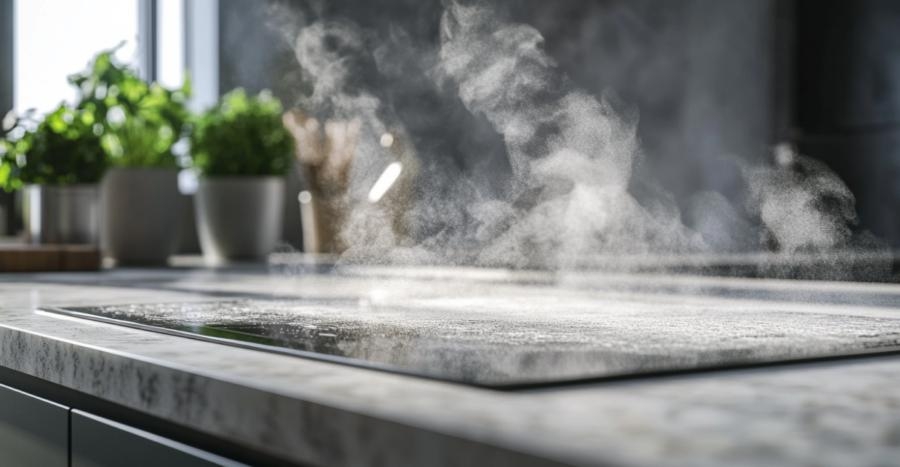Steam Mapping Kitchen Surfaces for Hidden Grime Patterns

Steam Mapping Kitchen Surfaces for Hidden Grime Patterns
An unexpected haze drifting across a countertop can reveal more about your cooking habits than any confession ever could, and using that haze deliberately turns out to be surprisingly effective. Steam has a talent for clinging to whatever your regular cleaning routine politely ignores, and that makes it a wonderfully revealing partner in kitchen maintenance.
Why Heat Exposes What Routine Wipes Miss
Heat loosens oils, softens sticky residues, and briefly fogs surfaces in a way that betrays every smear and streak. When the vapor settles, it outlines buildup with the enthusiasm of someone pointing out every plot hole in a movie. Areas you thought were spotless suddenly display cloudy fingerprints, faint grease halos, and the occasional mysterious blotch that seems to have no origin story.
Some sections of a kitchen never lie: the range hood, the handle of the refrigerator, the cabinet above the stove. A short burst from a steamer—or even a pot of boiling water placed strategically—can highlight the differences between clean and “clean enough for now” in seconds.
This step isn’t about shame. It’s about reclaiming control from grime that prefers to operate in stealth mode.
Gathering Tools Without Overcomplicating Things
You don’t need specialized gadgets worthy of a laboratory. In most cases, the following simple items do the job beautifully:
- A handheld steamer or kettle
- A microfiber cloth you aren’t emotionally attached to
- A nonabrasive cleaner
- Optional gloves if you’re the cautious type
A steamer provides more precision, but a kettle works surprisingly well if you direct the vapor carefully. Just remember that steam is hot—yes, really hot—so treat the process like you would any activity where gravity, physics, and reflexes occasionally disagree with you.
Performing Your First Steam-Mapping Sweep
Start with a cool surface so the steam has a chance to condense visibly. Move the steam source slowly across a section of your countertop or appliance. Watch for any patch where droplets cling longer or form uneven islands. That lingering condensation indicates residue—everything from old cooking oil to faded splatters that long ago blended into the décor as if they paid rent.
Once a patch is identified, wipe it with a dampened microfiber cloth and a small amount of cleaner. Repeat the steam test to confirm the spot is genuinely clean rather than merely smudged into a new shape.
Over time, this technique becomes strangely satisfying. There’s a certain joy in discovering a hidden smear and erasing it so thoroughly it feels like solving a personal mystery.
Adapting Steam Mapping to Different Kitchen Zones
Different surfaces respond to steam in their own unpredictable ways. Stainless steel tends to show streaks dramatically, as though auditioning for a before-and-after commercial. Wood can reveal tiny patches of oil you never asked for. Tile grout displays everything, proudly and without apology.
For appliances, aim the steam along edges, seams, and handles. These areas collect residue the way pockets collect forgotten receipts. You might notice areas that fog up unevenly, forming cloudy stripes. That’s your cue to give them some focused attention.
Cabinet doors—especially the ones near the stove—often tell the most compelling stories. A brief vapor sweep will outline every fingerprint and every micro-splash of cooking oil. The moment the haze appears, you’re given a clear map of exactly where to focus, saving you from cleaning the entire cabinet door when only a few square inches needed help.
Even your countertop can surprise you. Certain spots may collect residue from habitual prepping zones. Steam exposes these patterns without you needing to analyze your culinary behavior like an anthropologist.
Turning Steam Mapping into a Time-Saving Routine
Once you’ve run a few steam-mapping sessions, you’ll notice the same areas reappearing as problem zones. From there, you can build a short and efficient routine. Consider a weekly sweep in which you steam only the usual culprits.
A simple rhythm might look like this:
- Steam the stove and hood area
- Target fridge handles and nearby cabinets
- Check the prep counter and backsplash
This takes far less time than a full clean and gives you the satisfaction of precise maintenance rather than repetitive guesswork. You stop wiping areas that don’t need it and focus exactly where evidence says you should.
Steamy Endings and Fresh Beginnings
There’s a certain charm in watching residue betray itself the instant heat hits the surface. Some kitchens seem spotless until steam reveals the quiet rebellion of oils and smudges hanging on for dear life. Other kitchens wear their grime openly, unfazed by judgment, practically waving when steam drifts past.
Either way, steam mapping gives you clarity that no amount of squinting under overhead lights can match. It sharpens your awareness of how your kitchen actually accumulates mess, rather than how you assume it does.
With regular use, the process becomes both practical and oddly entertaining. You learn your kitchen’s quirks, its habits, its stubborn corners, and the zones that behave no matter what you cook. And when you finally wipe away the last patch of unexpected haze, there’s a sense of victory in knowing you didn’t just clean—you outsmarted grime on its home turf.
By letting steam draw the map, you simply follow the clues and enjoy a space that stays consistently brighter, fresher, and easier to maintain.
|
|







